Between picking your products and launching your business, there’s one important step – deciding on the best Shopify theme for your store. Shopify and other hosted ecommerce platforms make it super easy to launch a store: you just register for an account, select your store’s look, add products, and that’s it – you’re ready to go.
However, each step in the process of creating your store has to be carefully considered in order to succeed. Just like choosing a product category that is too broad or too narrow, a poorly designed store will turn your prospective customers off at first glance.
In fact, research shows that 42% of people won’t shop from poorly designed websites.
But generally, it’s fairly easy to find great Shopify templates. After all, there are several Shopify themes you can choose from, including a few free Shopify themes.
Today we’re going to go through some of the best free Shopify themes around, and underline why we believe they’re so great.
Best Free Shopify Themes for 2023
Finding the best free Shopify theme for your store is no easy task, but we’re here to help.
Below, you’ll find a list of free themes that are known for their responsiveness, usability, and aesthetic appeal.
→ Click Here to Launch Your Online Business with Shopify
We gathered these templates by combing through the web and analyzing the features and functionality of different themes to identify the best options for Shopify businesses.
With that said, here’s a look at the top free Shopify themes on the market.
1. Debut
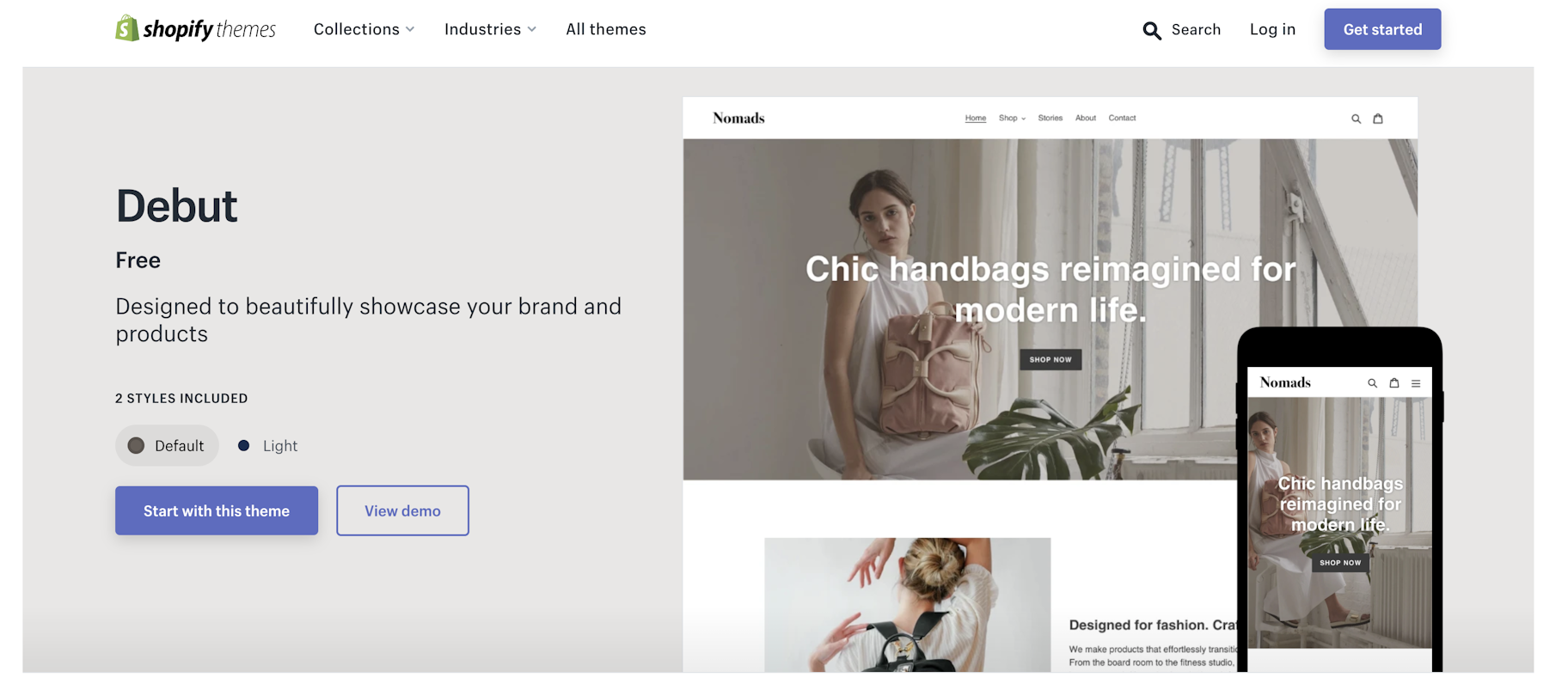
Debut is one of the best free web store themes to rely on if you’re just starting with your business.
It’s perfect if you’ve got a small number of products.
This free ecommerce theme will help you incredibly to highlight your products.
It’s available both in desktop and mobile versions, which as we mentioned, is always recommended for a better user experience.
This ecommerce website template is very light, super fast, and flows smoothly. Not just that but it’s also beautifully designed and brings attention to exactly where you want your customers to be.
So, quick recap, if you’re just launching your business, and you have ideally a small product catalog, this is a great web store theme for you to choose.
2. Brooklyn
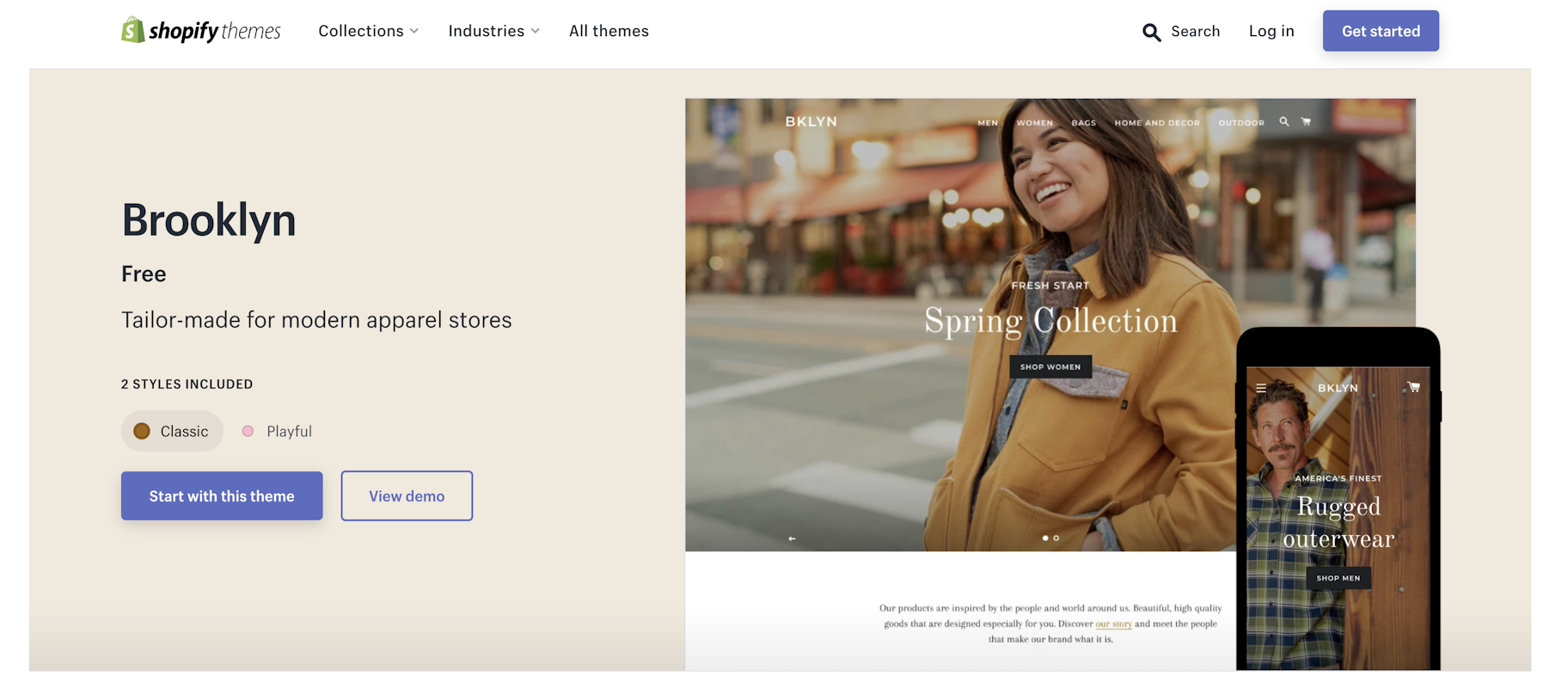
This free website theme is perfect if you have more of a general webstore.
Brooklyn has two styles: classic and playful.
The classic style is more serious, and the playful style seems more colorful and vibrant in comparison.
One of the best things about this free ecommerce theme is that it’s very customizable.
You can easily change up this Shopify theme according to your personal needs and requirements.
On top of that, it’s very fast, it’s very lightweight, it’s mobile optimized, and of course it’s supported by Shopify’s support team.
3. Simple
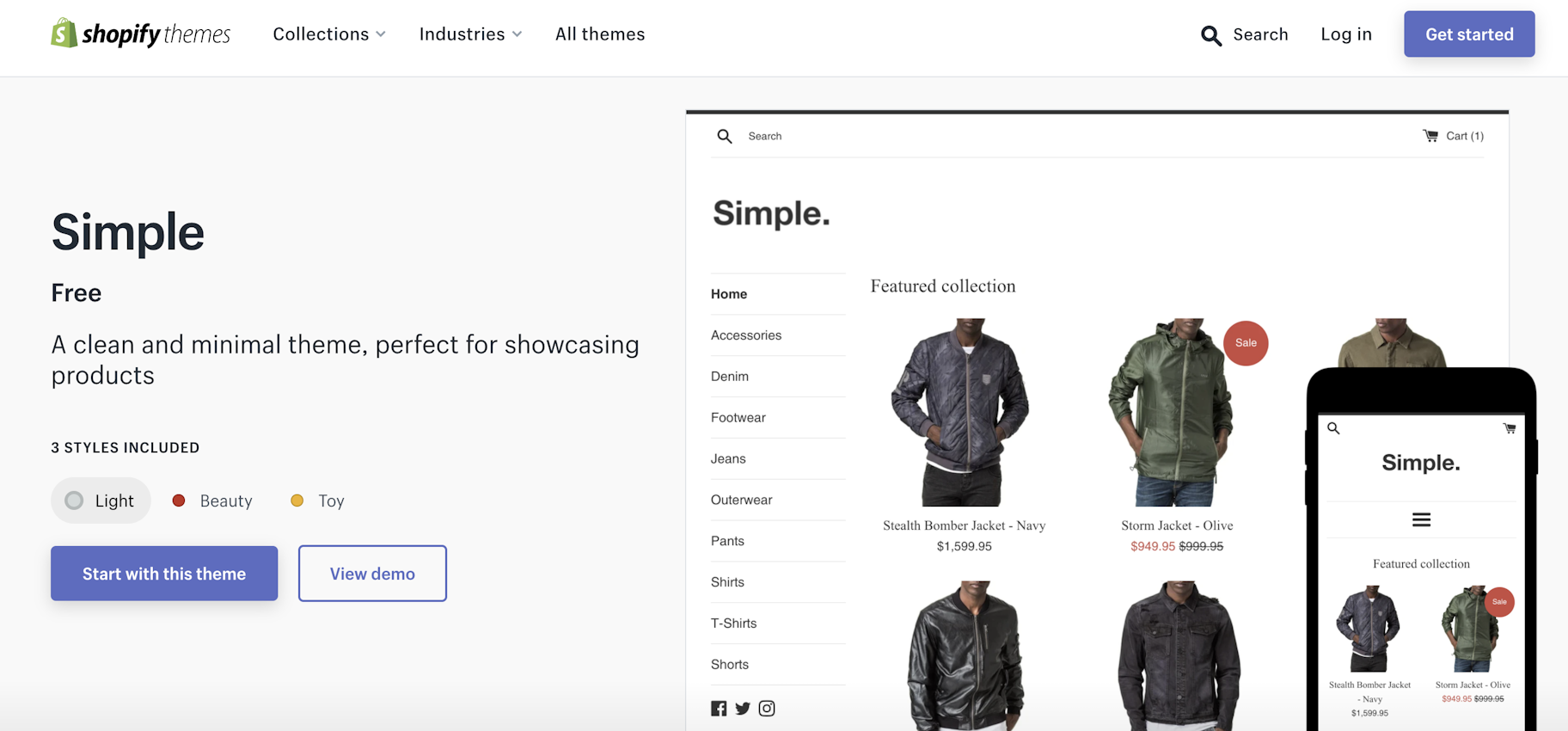
Want to put the spotlight on your products? Look no further than Simple.
This ecommerce template offers a clean, minimal design that puts your catalog at center stage.
What makes it one of the best free Shopify themes is that it offers a simple navigation experience and handy additional features such as a product image animation function and a sidebar module to easily display your items and collections.
And though Simple doesn’t have an eye-catching color palette, it looks good on all devices because of its simplicity. Rest assured, navigating your website is quick and effortless, courtesy of the minimalist set-up.
4. Narrative
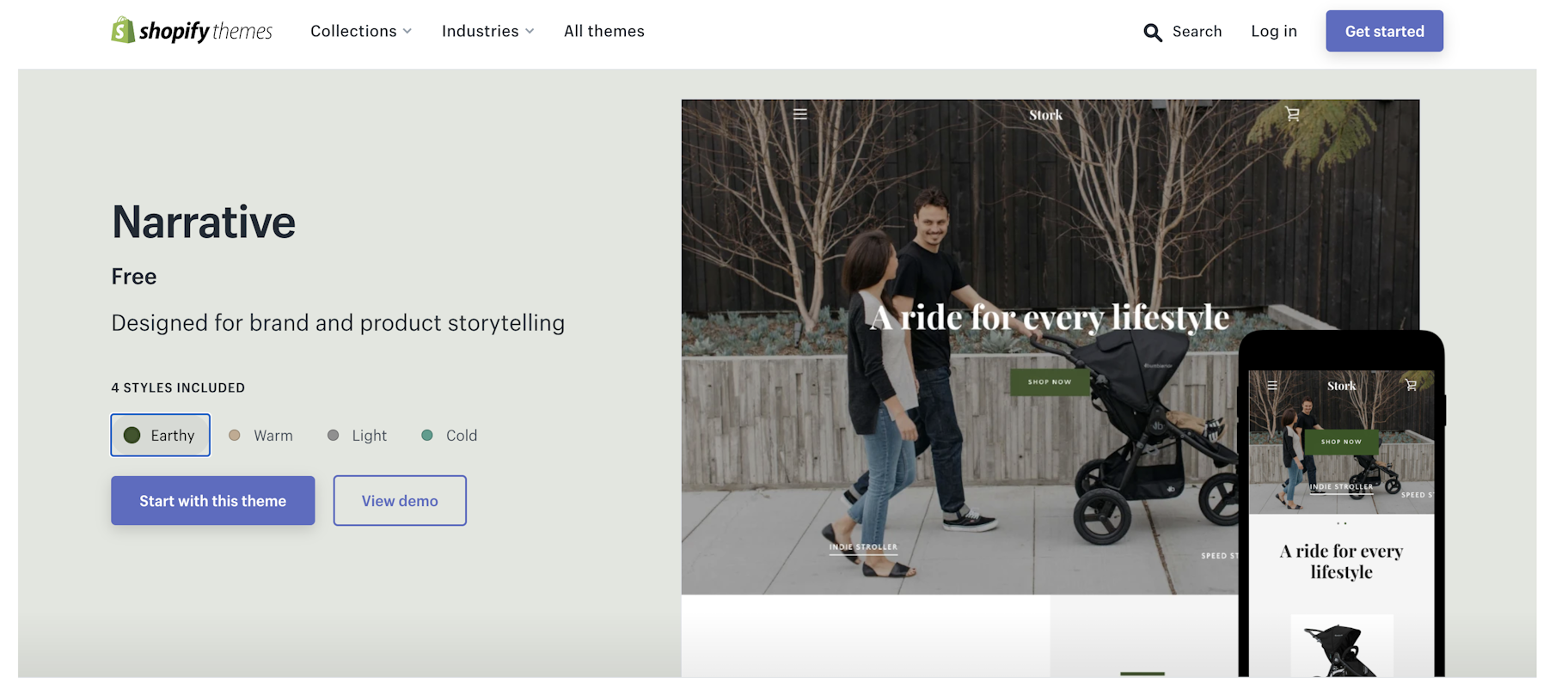
Narrative is the ideal Shopify theme to help you get started with product storytelling.
Customizable image blocks and vertical slideshow allow you to showcase your products in all their glory.
And the full-width layout helps you make the most of large, high-resolution product images.
Whether you’re selling a single product or a number of products, you can count on the theme to highlight your items in the best manner possible.
5. Supply
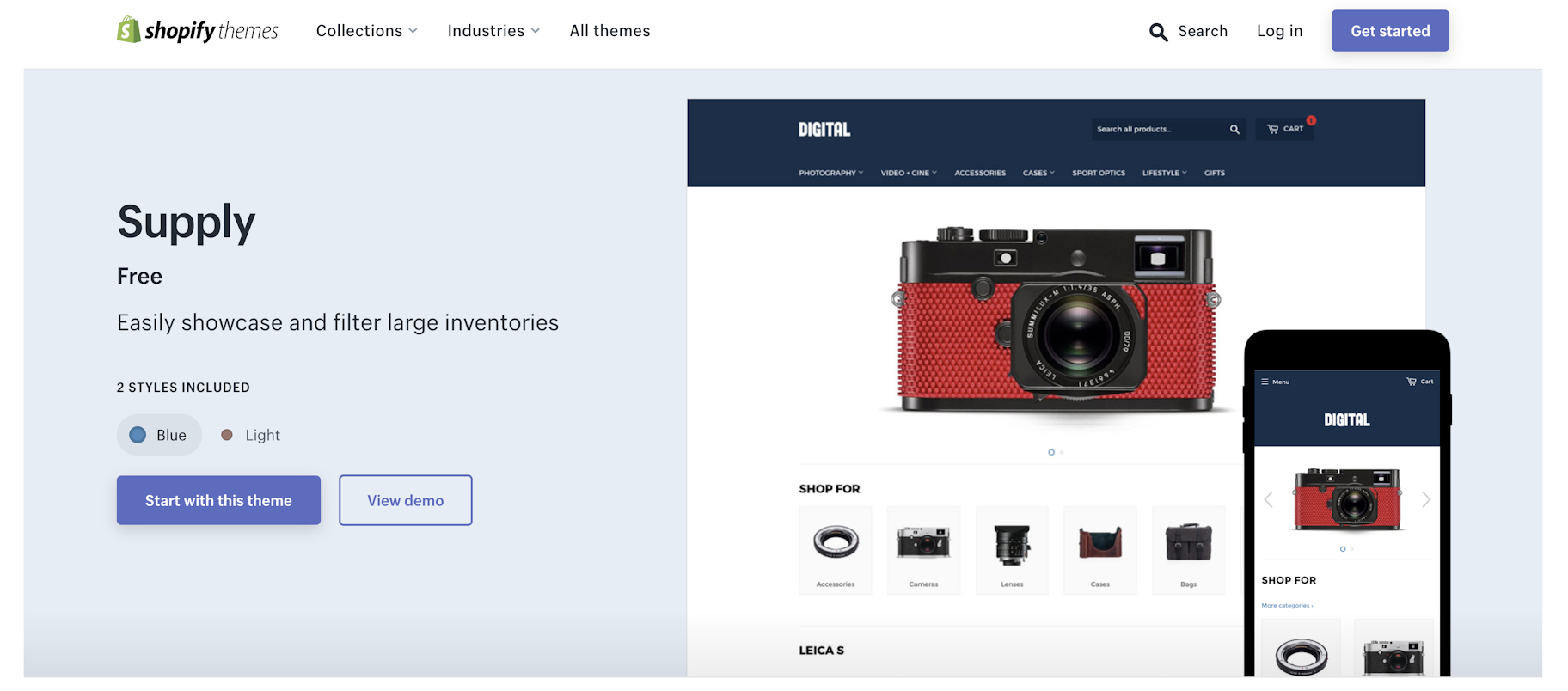
Supply is a free Shopify theme designed for ecommerce stores with large inventories.
One of its standout features is the multi-column menu. You can use it to organize your website while making it simple for customers to navigate all of your item categories.
Additionally, you can feature specific products you’d like to endorse along with the categories using the multi-column feature.
All of that makes Supply a solid starter theme for those looking to keep their site easy to navigate and their products organized.
6. Express
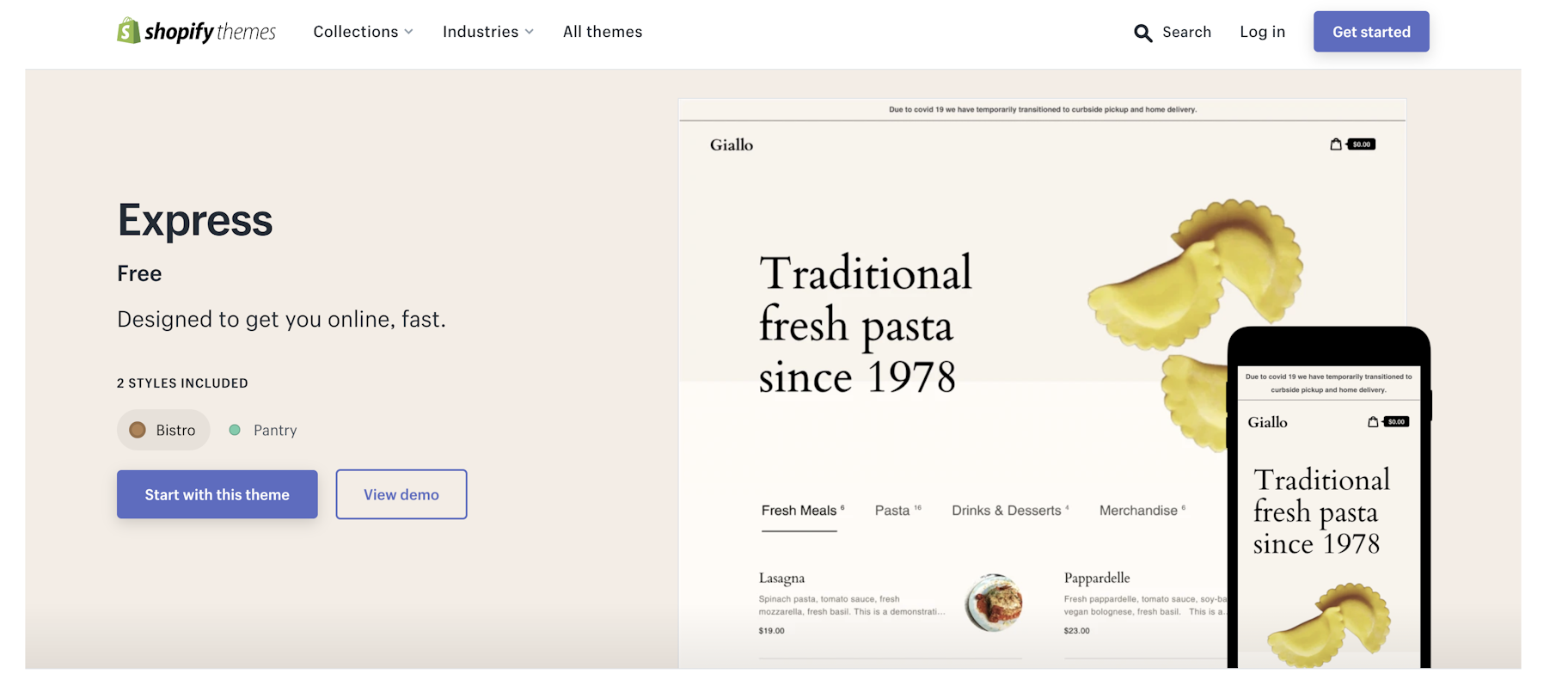
Can’t wait to start selling products online? Consider using Express as your Shopify theme.
It allows you to showcase your content and products on one page for instant selling.
A quick buy option is also there to enable customers to add products to their cart without leaving their existing page.
Overall, the theme is ideal for ecommerce entrepreneurs looking to get online – fast.
7. Venture
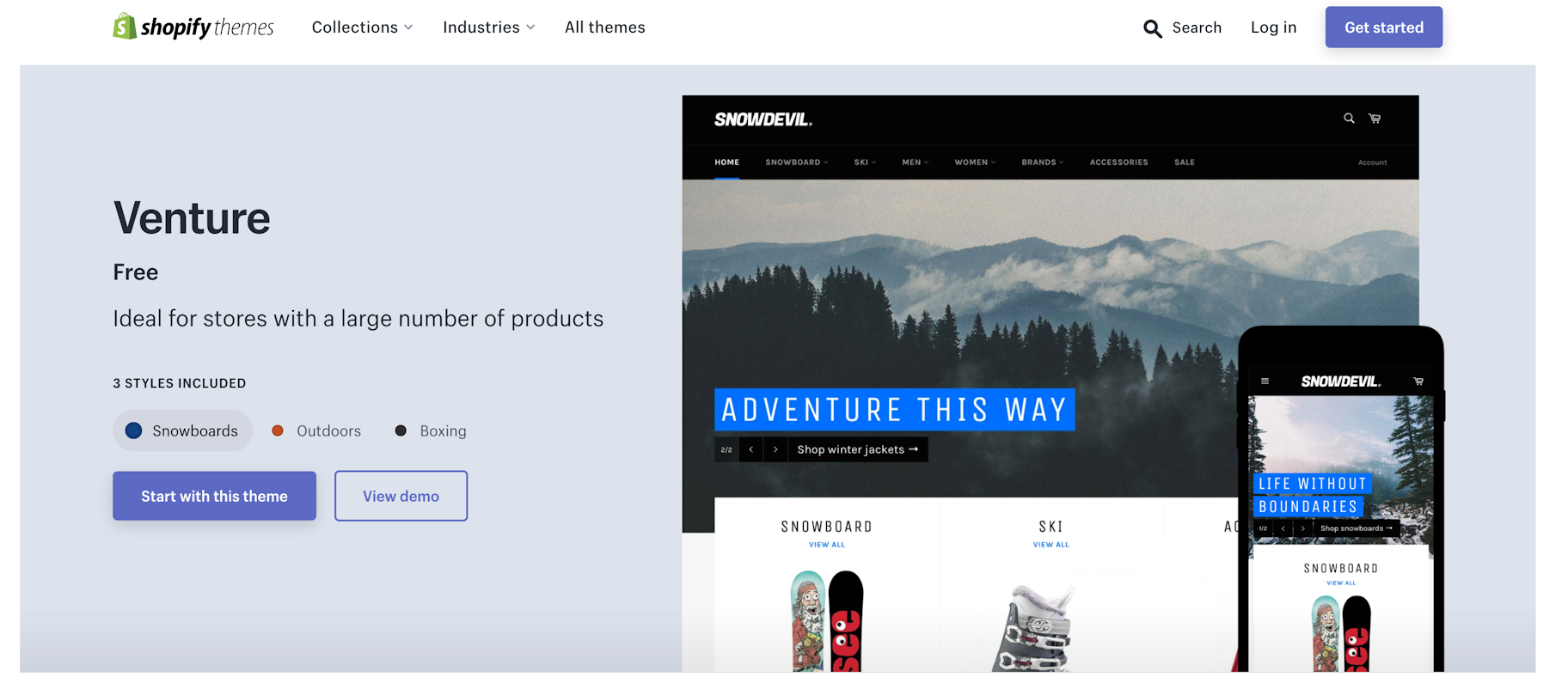
This free Shopify theme is best for online stores that run frequent promotions, sales, and discounts on their products.
Through a promotional banner, you can highlight which products are on sale and the total discount available.
Besides, Narrative allows customers to sort products by price and best sellers on the collection page while keeping them well-organized and displayed.
Use Narrative to make shopping exciting for your customers, so they keep coming back and spread word-of-mouth about your business.
More Free Themes
These themes are made by Shopify, and one of the greatest things about them is the support that you receive from Shopify while using them.
Shopify has the customer support infrastructure behind them that can help you with your custom queries about the Shopify themes.
So, let’s say you’re just starting off, looking for one of the best Shopify themes in 2023, and you really need some questions answered.
When you’re just starting off with your store, and are already overwhelmed with a bunch of choices, make your starting a lot easier by relying on these simple, yet fantastic options that Shopify provides you in terms of free ecommerce themes.
Also, you can browse through other free Shopify themes here.
How to Pick the Best Shopify Theme
Okay, now that we’ve covered what a Shopify theme is, it’s time to get into the nitty gritty of picking a Shopify theme for your ecommerce business.
Here are some things to keep in mind before picking your Shopify theme:
1. Make Sure Your Shopify Theme Looks Familiar
According to Krug’s first law of usability, the website should be obvious and self-explanatory. Or, in his words, “Don’t make your users think.”
The best Shopify themes follow a conventional design and use widely accepted methods and layouts. Free Shopify themes also follow the same design principles.
Next, you’ll need to think about the position of your ecommerce cart and checkout pages — you’ll never look for them in the footer of a website, right?
Shopify themes are perfect for your ecommerce store as they have a consistent look and feel which buyers are already comfortable with. You’ll find that playing it safe by using a simple design is often best for converting potential customers. We believe that some of the best Shopify themes are familiar and intuitive for your customer.
Let’s take a look at what a poorly designed ecommerce website template looks like.
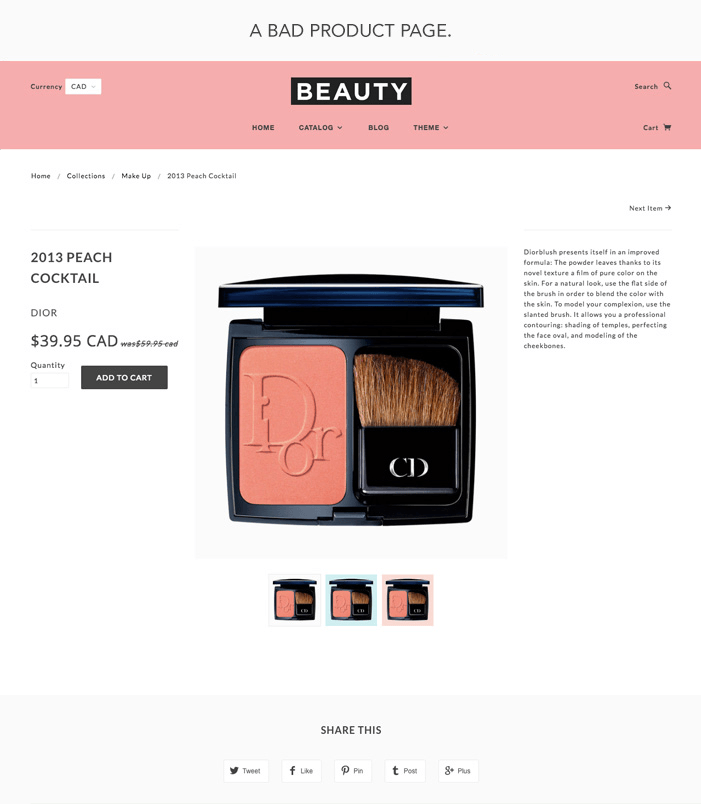
The above product page has an extremely unfamiliar look. Let’s shed some light on all the things which cause this unfamiliarity:
- The product image is placed between the product description and Call-to-Action button/price.
- The product description itself isn’t focused on the benefits which the product can bring to a buyer, and it’s squeezed into the corner of the page.
- This is definitely room to add in some reviews and testimonials that could boost social proof.
- There’s a lack of variety when it comes to the product images.
- It can’t be overstated: product photography is very important. The pictures on this product page here are sort of one-dimensional. Try to add pictures that accentuate the products. You don’t need to be a pro to take fantastic product photos – all you really need is your smartphone.
- The features of this product are not clearly defined.
- The Call-to-Action button isn’t prominent to grab attention. Take a look at this post if you’re looking to create a killer Call-to-Action.
Alright, now let’s take a look at the product page of an ecommerce website theme that stands out because it’s so brilliant.
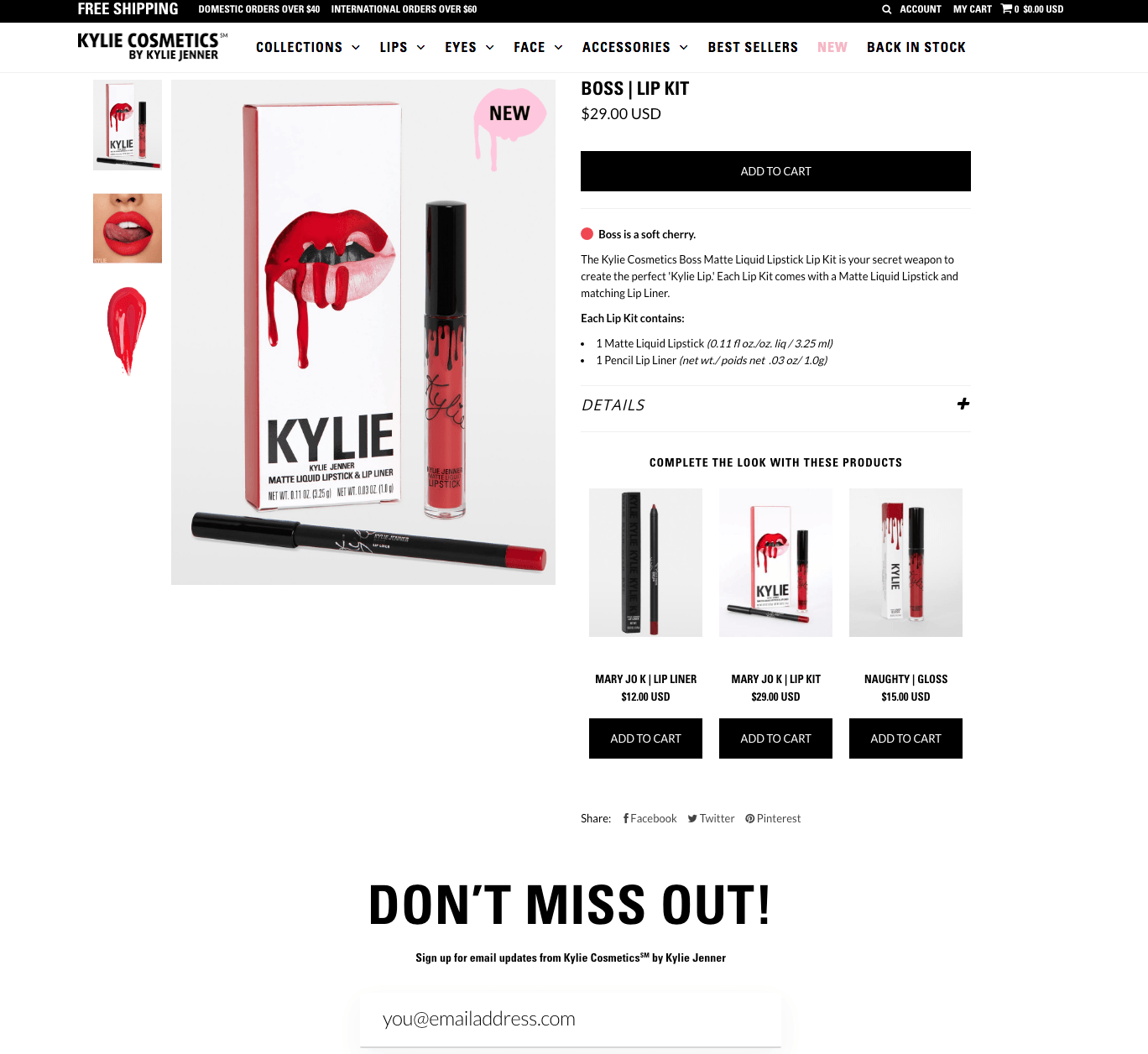
The above image shows a highly recognizable Shopify theme for beauty products. Let’s take a look at all the superb things that make this Shopify theme great:
- The imagery is breathtaking. It’s highlighting the product in isolation as well as underlining what the product looks like in use.
- There’s a very clear Call-to-Action on the page, you just can’t miss it.
- The Shopify theme allows this product page to be interactive. If you move your cursor around the image and click you can zoom into the product. You can also browse through different pictures with just a few clicks.
- This product page includes a detailed description of exactly what the product contains, right next to the product.
- This product page lets you easily get to other products that are similar or belonging to the same product line.
- You can simply click on the plus sign to the right of “details” and get a bunch of extra info that lets you dive right into the details that you’re looking for.
- You can even add your email address on the same page, and sign up for more updates from their products.
2. Think of Your Resources When Selecting a Shopify Theme
It’s true that dynamic visuals are extremely important when engaging your website visitors.
But generally, entrepreneurs using Shopify themes tend to stick to simple layouts which utilize banners.
So, when you’re choosing a Shopify theme, you’ll want to decide how much you can invest into the images you use.
If you are tight on funds, or reluctant to splash the cash, know that you don’t need to spend vital resources on your Shopify theme.
There are plenty of free Shopify themes, or free ecommerce themes which will prove to be effective for your ecommerce business.
Shopify templates, even the free ones, can increase your conversion rate even if they’re simple in design.
While it may not be your first choice, it will get the job done as you bring in your first few sales. As your business’ profits grow, you can re-invest money in some of the best Shopify themes to give your store a more attractive layout.
If you don’t have the resources to design beautiful banners, you don’t need to use them – you can look for those Shopify themes which put the focal point on products instead.
3. View Your Products on the Shopify Theme
When you’re browsing through the different Shopify themes, you can also check what your products will look like on many Shopify templates.
Shopify theme designers generally insert premium product images into their themes, which will suit their style perfectly.
You can try to replicate this by using images of your own products, but unless you’re familiar with design then it may not look the same when you install the Shopify theme into your own store.
If you don’t currently have high-quality product images, it’s best to avoid Shopify templates which feature large product image sections.
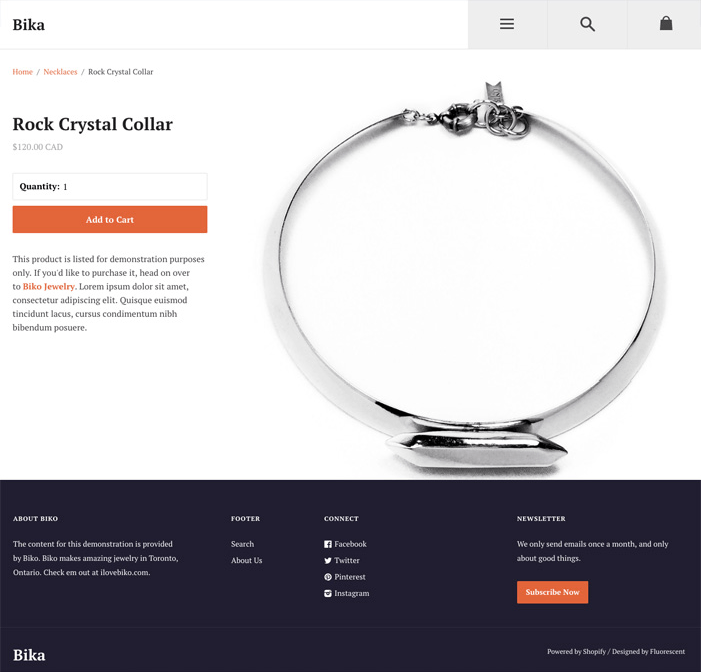
Bika’s website theme looks awesome, but are you sure you’ll have high-quality images like this one?
4. Consider a Mobile Friendly Shopify Theme
Mobile friendly ecommerce websites are more important than ever before.
More than 50% of sales on Shopify stores happen on Mobile devices. Given this fact, it’s imperative that you choose your Shopify theme with the mobile version in mind.
Why?
Well, if your Shopify theme is mobile-friendly, it’s going to provide a better overall user-experience for all of your website visitors.
It’s a fairly simple task for you to complete when you’re looking for a Shopify theme, however, most entrepreneurs forget to do it.
They only take the time to analyze and optimize their mobile experience after they’ve installed the Shopify theme into their site.
That’s where you can get ahead of the game.
Check the look of your Shopify theme on both your smartphone and your tablet before you launch your store to the public.
And again, try to look for mobile layouts which are familiar for your shoppers.
If you’re thinking about using a free Shopify theme, don’t worry – they’re still mobile friendly too, just like some of the best free Shopify themes, which can incur fees.
Always try to keep mobile responsiveness in mind when you’re looking for the best Shopify theme for your store.

Take a look at the free Shopify theme Venture, which offers a very well done mobile experience.
5. Look for Lightweight Shopify Themes
Try to avoid Shopify website templates which have a lot of clumsy elements like busy loaders, unnecessary animations, or fancy scrollers.
The above-mentioned elements might appeal to some of your website visitors, but in most cases it will only decrease your page speed and create needless obstacles.
You want your Shopify theme to make it as easy as possible for buyers to land on your website, find the products that they’re interested in, and make the purchase.
In fact, all of the best Shopify themes provide a lightweight website that is focused around making a customer’s shopping experience as easy and as quick as possible.
For additional context about how important lightweight websites are – it’s said that if loading speeds would decrease by one second, an ecommerce site that makes $100,000 per day could lose $2.5 million in annual revenue.
That’s huge. It’s also evidence of how important it is to be clever when you’re selecting your Shopify themes.
Of course, the numbers will be much smaller for your store when you’re starting out, but it’s important to keep in mind that you need lightweight Shopify themes.
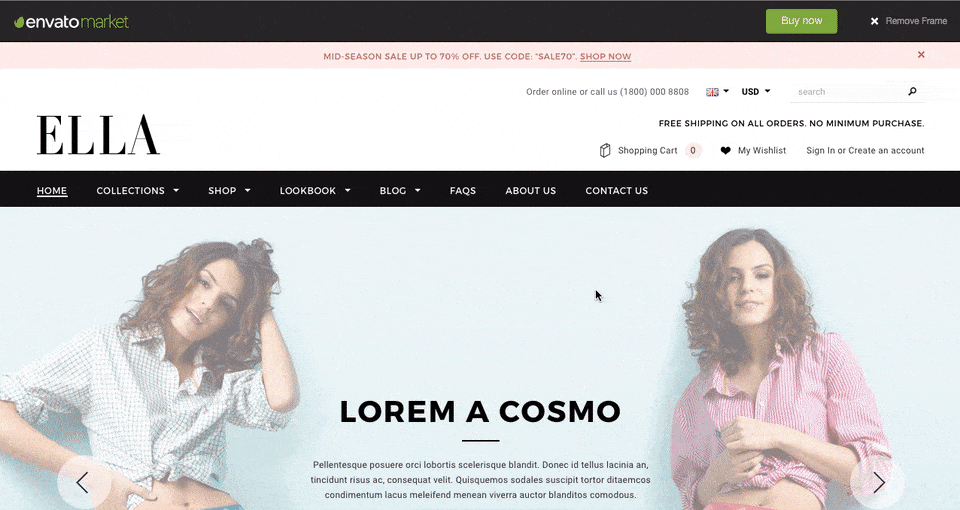
6. Make Sure the Shopify Theme Is SEO-Friendly
Search engine optimization isn’t only important for content-based websites. Your online store also requires a healthy dose of SEO magic to be discoverable in search engines.
Thankfully, many Shopify themes come with built-in SEO features to make your site rank better.
Consider installing a theme that has a clear, logical structure for how everything will be organized. Google likes ecommerce sites that have a clean architecture, as they’re balanced and easy to follow.
So, make sure to pick an SEO-ready Shopify theme to help search engines index your pages and send people your way. You can even combine this with Shopify’s SEO features (page titles, meta descriptions, etc.) to give exposure to your business.
7. Go Through Reviews to Validate Your Choice of Shopify Theme
As with anything, reviews are a great way to leverage the experience of others to help you make the right decision.
Fortunately, all Shopify themes listings have a section where users can rate and give their feedback on the theme.
Dive through these reviews to see if the theme you like has all the elements to power your online store or, on the contrary, is missing an important feature.
For example, the Shopify theme Simple has lots of positive ratings and reviews, indicating that it stays true to helping store owners create a clean, minimalistic storefront.
Disclaimer: All the ideas mentioned in this article are our own. You can find different approaches elsewhere, and they’re not necessarily wrong. Our suggestions are geared towards beginners, but if you have something to add, please share it in the comments!
Common Questions About Ecommerce Website Themes
What is the Best Shopify Theme
If you’ve been looking for a definitive answer for the best Shopify theme, we’ve got some bad news: there isn’t a definitive winner.
The best Shopify theme for your business could end up being totally different to the theme that a store which focuses on another niche would use.
The best Shopify theme is one that suits your business’ aesthetics, without breaking the bank.
Are Free Shopify Themes Worth It?
Yes. Free Shopify themes offer many of the most important elements that are needed to create a successful store. Fortunately, you’ll still be able to customize it to make it your own branded store.
Shopify themes are highly customizable, and you can create a unique store, even if you don’t have the best technical experience.
Free Shopify themes may not be your first pick. However, if you’re just starting out with your ecommerce store, it’s better to be cautious with what you spend your money on. Once your store is starting to succeed, you can re-invest it by picking from one of the many paid Shopify templates.
In all free Shopify website themes, you’ll be able to add products, blog posts, banner images, and more.
Make sure that you do pay for your own .com domain name as it will make your store look more professional, and will help you to increase your conversion rate. Overall, free Shopify themes are the best option for ecommerce entrepreneurs running their store on a budget, but they’re also used by successful ecommerce stores.
What Does a Good Product Page Look Like?
Your product pages are the most important parts of your store.
It’s where you should lead your ad campaigns, it’s where you display your offers, it’s where the actual sale is initiated.
In light of this, it’s critical that you have good looking product pages, or you’ll miss out on sales.
Pick your Shopify theme based on this.
What Are the Must Have Elements for Shopify Templates?
The best Shopify themes all share the same must-have elements.
Besides elements like product images and price tags, your product page must contain a distinct Call-to-Action button (in most cases an “Add to Cart” button).
Next, a good product page displays all the relevant information, but doesn’t clutter the page.
You should have a place to include product descriptions, specifics, delivery information, and returns/refund information.
Ideally, you would use your Shopify theme to display these in separate tabs below the product, but a simple description tab would work too.
Furthermore, to keep your visitors attention, your product page shouldn’t be the end page of your store, instead it should lead to other products to prompt browsing visitors.
The related products section works well, and if your Shopify theme doesn’t have one, you can always install a free Shopify App.
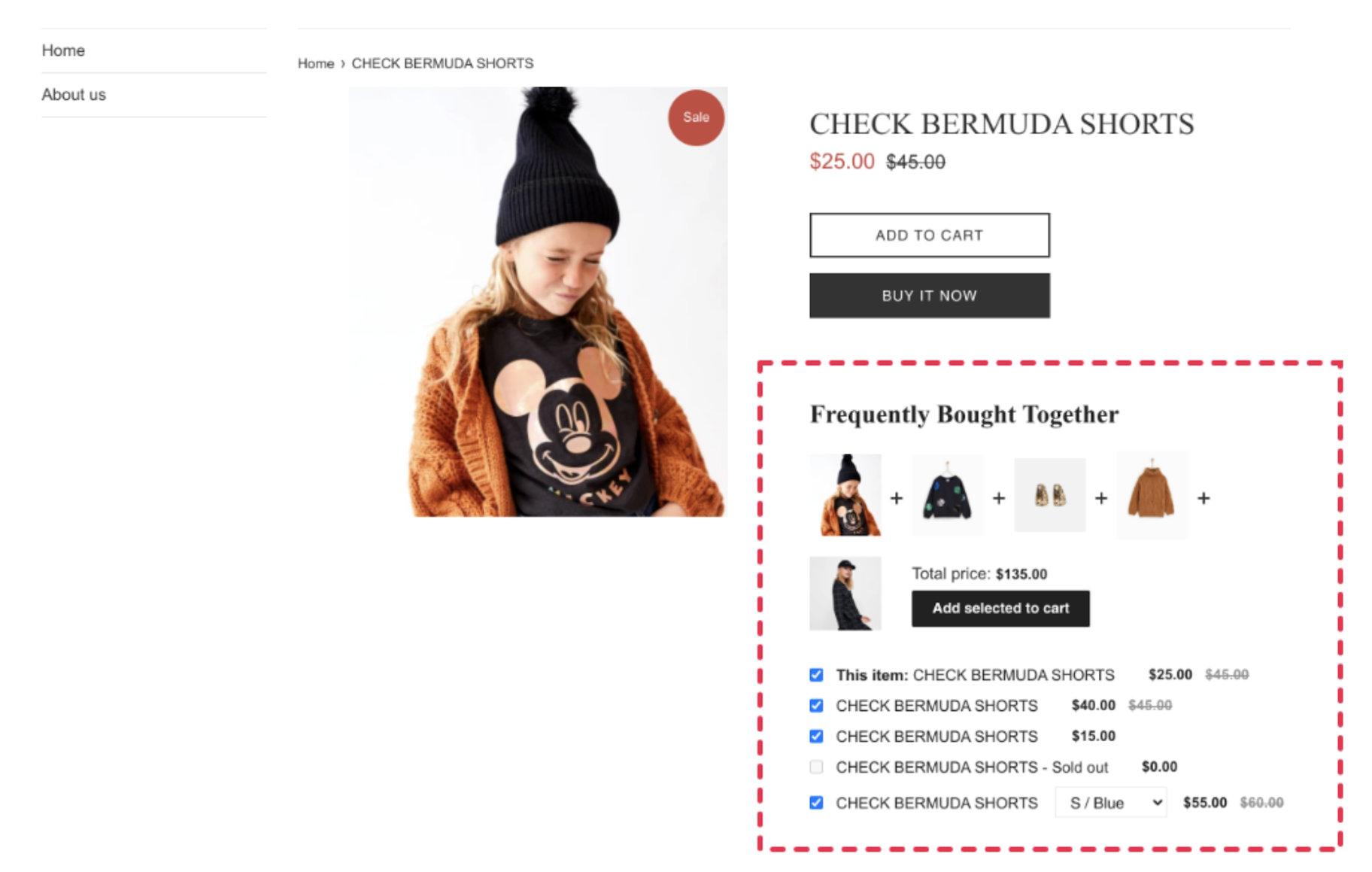
Bonus: To keep your site trustworthy, add social proof using security badges or reviews.
You can add these into your Shopify theme by installing apps from the App Store like Yotpo.
What is a Good Product Page Layout?
Like I mentioned earlier, a good product page looks familiar and is intuitive to use.
A web design blog, Smashing Magazine, gives an example of how intuitive it should be:
“…translate the page in Japanese and provide [your visitors] with a task to find something in the page of different language. If [it’s layout is familiar/intuitive], users will be able to achieve a not-too-specific objective, even if they can’t understand a word of it.”
Look at the LightInTheBox.com product page in Czech — try to see if they ship to the US. Can you tell which button is the Buy Now button?
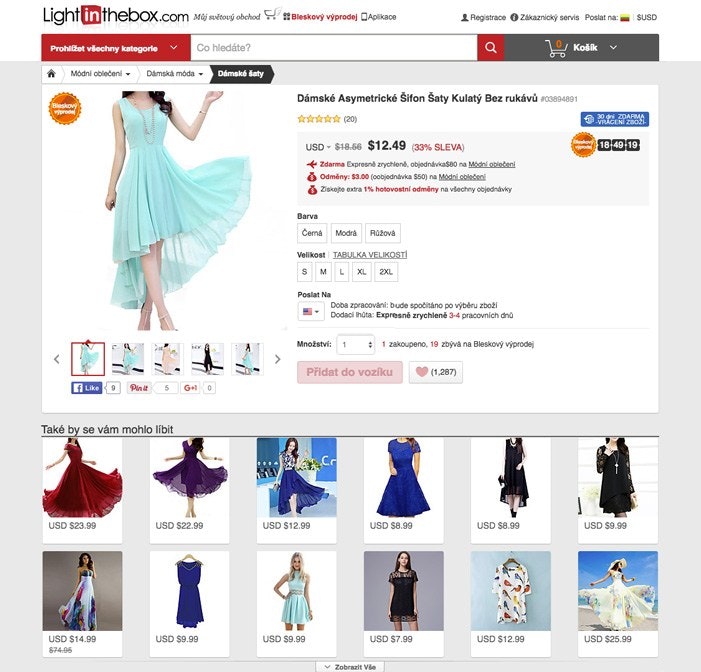
You don’t have to do this for every page on your commerce store, but this will truly test the customer experience with your Shopify theme if you do.
What Does a Good Category Page Look Like?
Consider the things we talked about above (Think of Your Products, Think Mobile, etc.) and just make sure it’s easy to navigate, without a lot of clutter or needless elements.
The best Shopify themes typically provide a good category page that consists of a clear title, easy navigation sidebar, and a clean list of products. To get a better grasp on how it should look, here’s an example:
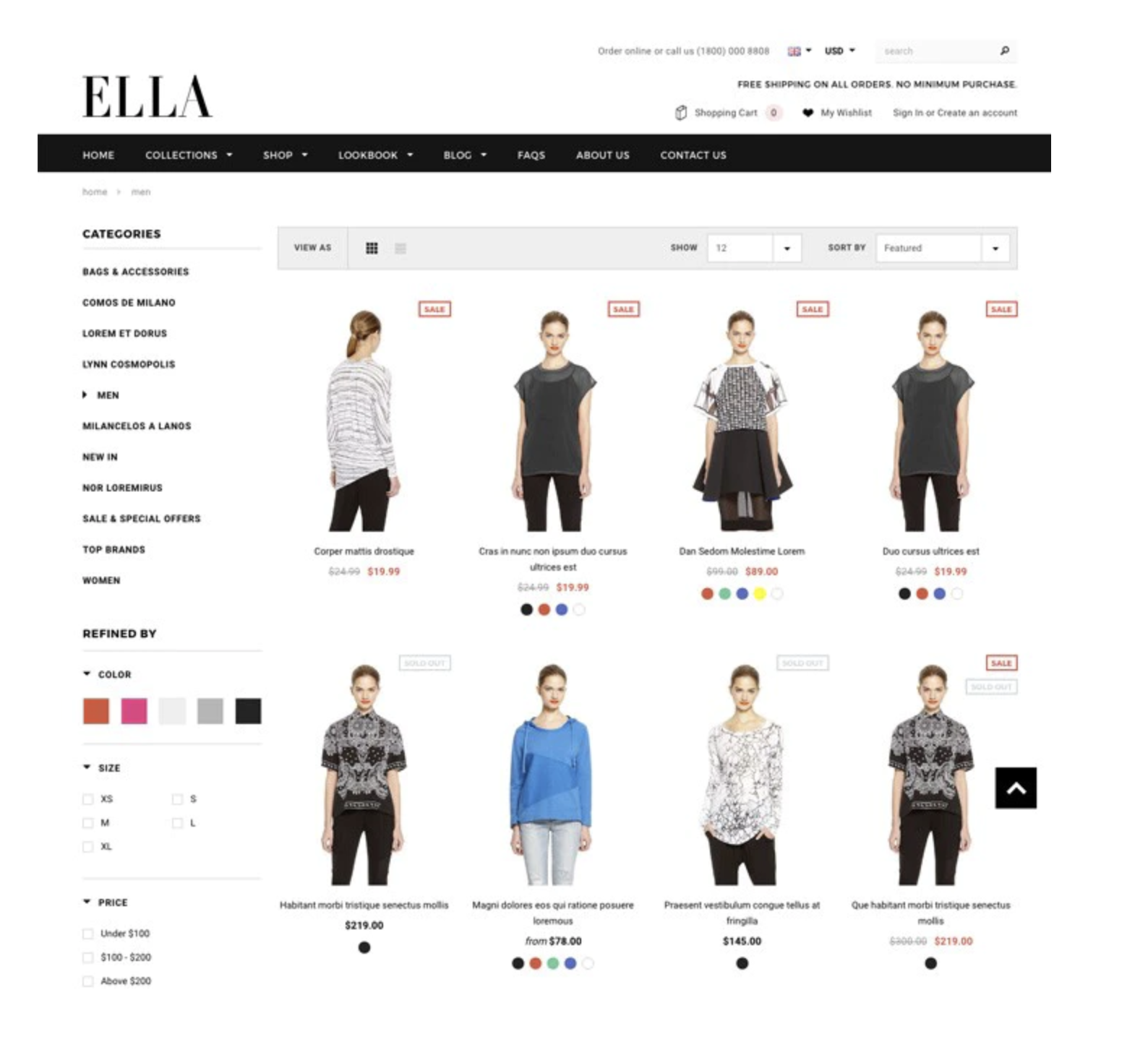
A comprehensive category page from ELLA theme.
What Does a Good Home Page Look Like?
From my own experience, the ecommerce landing page that is mostly visited by repeat customers and referrals is the homepage — so use it to serve both audiences:
- Showcase your stores new arrivals to engage with returning visitors.
- Tell your store’s key value proposition, showcase your best sellers, and include trust boosting elements (security badges, etc) to engage the referral traffic.
- Create a friendly atmosphere that will entice potential customers into making a sale.
If you don’t have the resources to design a great looking slider and update it frequently, don’t include it in your home page or you might scare your customers away.
Mark it down as something that you can add to your Shopify theme later on.
Surprisingly, some actually go on to say that a slider is a conversion killer. Having only one banner typically converts best.
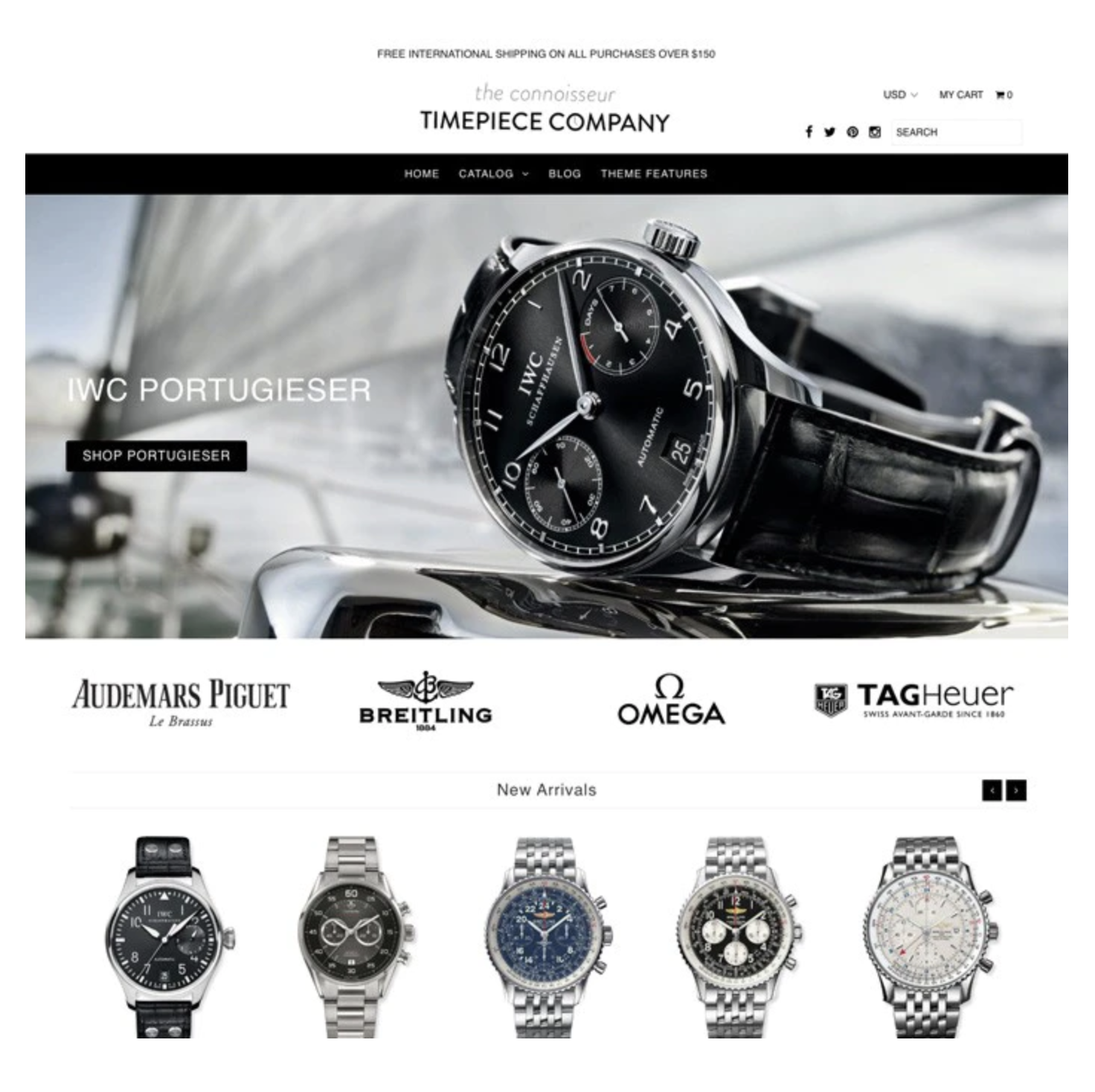
The Connoisseur theme welcomes visitors with a section of featured brands to give the store more credibility and grabs the prospect’s attention with new products.
How to Customize Shopify Templates?
In the end, even the best Shopify templates will be customized by you. Being non-programmer friendly, Shopify provides an easy to use editing panel to edit the look of your theme.
Just go to Online Store > Themes > Customize Theme, and on the right-hand sidebar, you’ll see each section of your theme: Header, Body, Footer, etc.
Play around with each to get the feeling of what can be done with the Shopify theme that you’ve chosen.
Advanced Editing: Unless you’re a developer, you should avoid changing your template code. Oftentimes, changing the code will mean you will end up publishing bugs, such as errors on the mobile Shopify theme or ruin other elements on the other side of your page. Some of the best Shopify themes will come with customization help directly from the developer, but this is unlikely with free Shopify themes.
Summary: How to Pick The Best Shopify Theme For Your Ecommerce Store
Okay – that’s it for today. That was our roundup of some of the best Shopify themes for 2023, and our overview of the things that you need to consider when you’re looking for a Shopify theme for your own store.
In summary, here are 7 important considerations to make before selecting your Shopify theme:
- Make sure your Shopify theme looks familiar to shoppers.
- Choose a theme based on your resources.
- See what your products look like on the Shopify theme.
- Opt for a mobile-friendly website template.
- Look for lightweight Shopify themes.
- Choose an SEO-friendly Shopify theme.
- Look up reviews to validate your Shopify theme decision.
So, do you think we missed off any information about Shopify themes? Was there a specific Shopify theme that you love which we missed off our list?
Let us know in the comments section below – we read them all.





